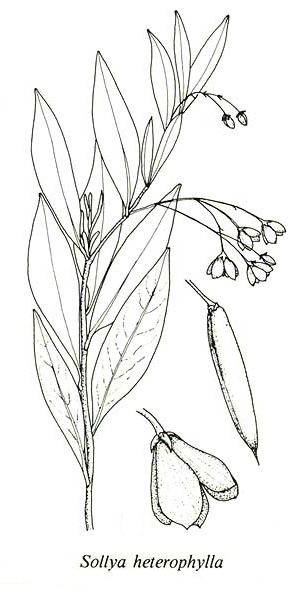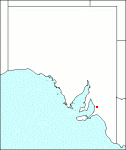Family: Pittosporaceae
Sollya heterophylla
Citation:
Lindley, Edward~ Bot. Reg. 17:t. 1466 (1832).
Synonymy: Billardiera fusiformis Labill., Nov. Holl. Pl. Sp. 1:t. 90 (1805); Labillardiera fusiformis (Labill.) Schultes in Roemer & Schultes, Syst. Veg. 5:330 (1819); S. fusiformis (Lamn.) Briq., Ann. conserv. Jard. Bot, Grenève 20:423 (1919), nom. illegit.; S. fusiformis Payer, Organog. 1:t.34 (1857); S. linearis Lindley, Edward~ Bot. Reg. 26:t.3 (1840); S. salicifolia Marnock, Flor. Mag. 4:62 (1839); B. hambruchiana Seemann & J.C. Schmidt, Flora 27:496 (1844); Xerosollya gilbertii Turcz., Bull. Soc. Nat. Mosc. 27, 2:362 (1854); S. angustifolia Lindley, Edward's Bot. Reg. 17:t. 1466 (1832), nom. illegit.; Pronaya lanceolata Turcz., Bull. Soc. Nat. Mosc. 27, 2:364 (1854); S. heterophylla Lindley var. angustifolia Benth., Fl. Aust. 1:126 (1863); S. erecta C.R.P. Andrews, J. Proc. Muell. Soc. W. Aust. 10:38 (1902).
Common name: Sollya, Australian blue-bell, bluebell creeper. (Wrigley & Fagg (1979) Australian native plants, opp. p. 336.)
Description:
Twiner or flexuose shrub; leaves narrow-lanceolate, 16-60 x 2-22 mm, acute, glabrous to pubescent.
Inflorescence a terminal or axillary drooping corymb of up to 5 flowers; flowers pedicellate; sepals ovate to lanceolate, 1-3 x c. 0.5 mm, dark-blue, margins ciliate; petals blue to dark-blue, lanceolate, 4-12 x 2-3.5 mm, acute; ovary densely pubescent, ribbed, 4-4.5 mm high.
Young fruit densely hirsute, becoming more or less glabrous with maturity; seeds embedded in pulp, flat to spherical, 1.5-2 cm long, papillate, black.

| Sollya heterophylla
|
Image source: fig 234c in Jessop J.P. & Toelken H.R. (Ed.) 1986. Flora of South Australia (4th edn).
|
|
|
Distribution:
|
native to W.Aust. Occurs in Tas.
|
Conservation status:
naturalised
Flowering time: mainly Nov. — March.
|

SA Distribution Map based
on current data relating to
specimens held in the
State Herbarium of South Australia
|
Biology:
No text
Author:
Not yet available
|

